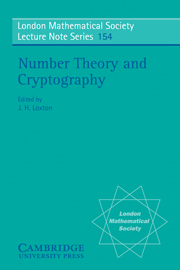Book contents
- Frontmatter
- Contents
- Contributors
- Introduction
- I NUMBER THEORETIC ASPECTS OF CRYPTOLOGY
- II CRYPTOGRAPHIC DEVICES AND APPLICATIONS
- 7 Security in telecommunication services over the next decade
- 8 Linear feedback shift registers and stream ciphers
- 9 Applying randomness tests to commercial level block ciphers
- 10 Pseudo-random sequence generators using structured noise
- 11 Privacy for MACNET
- 12 Authentication
- 13 Insecurity of the knapsack one-time pad
- 14 The tactical frequency management problem: heuristic search and simulated annealing
- 15 Reed-Solomon coding in the complex field
- PART III DIOPHANTINE ANALYSIS
12 - Authentication
Published online by Cambridge University Press: 05 May 2013
- Frontmatter
- Contents
- Contributors
- Introduction
- I NUMBER THEORETIC ASPECTS OF CRYPTOLOGY
- II CRYPTOGRAPHIC DEVICES AND APPLICATIONS
- 7 Security in telecommunication services over the next decade
- 8 Linear feedback shift registers and stream ciphers
- 9 Applying randomness tests to commercial level block ciphers
- 10 Pseudo-random sequence generators using structured noise
- 11 Privacy for MACNET
- 12 Authentication
- 13 Insecurity of the knapsack one-time pad
- 14 The tactical frequency management problem: heuristic search and simulated annealing
- 15 Reed-Solomon coding in the complex field
- PART III DIOPHANTINE ANALYSIS
Summary
The two main concerns in the authentication of information are verification that the communication originated with the purported transmitter and that it has not subsequently been altered. A model for the authentication channel is presented with two types of attack, by substitution and impersonation. The ideas are illustrated by a practical authentication system which can be used when both the transmitter and receiver will cheat if they can get away with it.
Introduction
In both commercial and private transactions, authentication of messages is of vital concern. For example, a person accepting a cheque usually insists on some identification of the issuer or authentication of the originator, and the person issuing the cheque not only fills in the face amount in numerals but writes out the amount in words to make it more difficult for anyone to alter the face amount on a cheque bearing his signature. This example illustrates the two main concerns in the authentication of information, namely verification that the communication originated with the purported transmitter and that it has not been subsequently altered. The contemporary concern is with situations in which the exchange involves only information, as for example in Electronic Funds Transfer (EFT).
- Type
- Chapter
- Information
- Number Theory and Cryptography , pp. 149 - 155Publisher: Cambridge University PressPrint publication year: 1990



